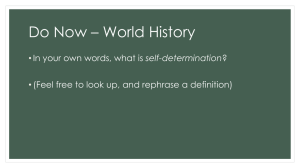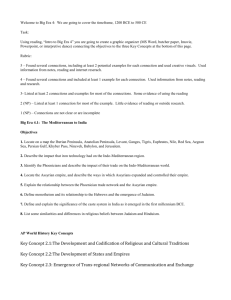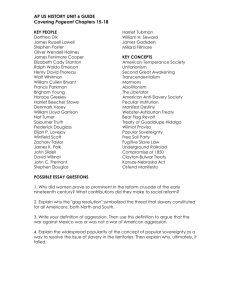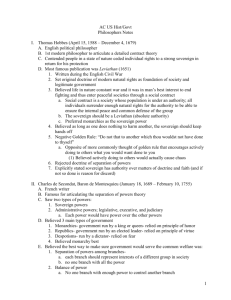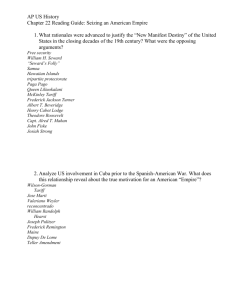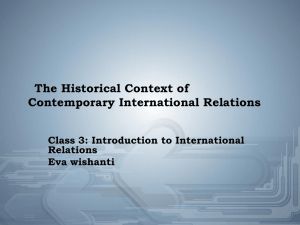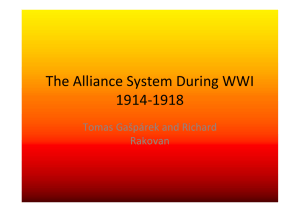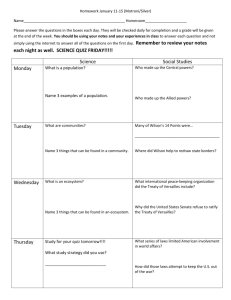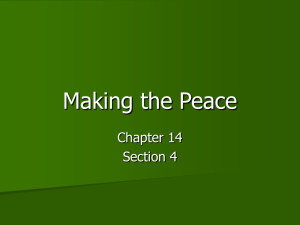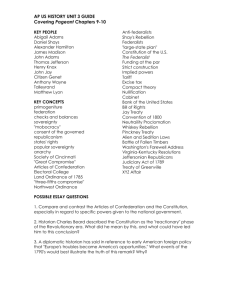Chapter 2: Historical Context of Contemporary IR
advertisement
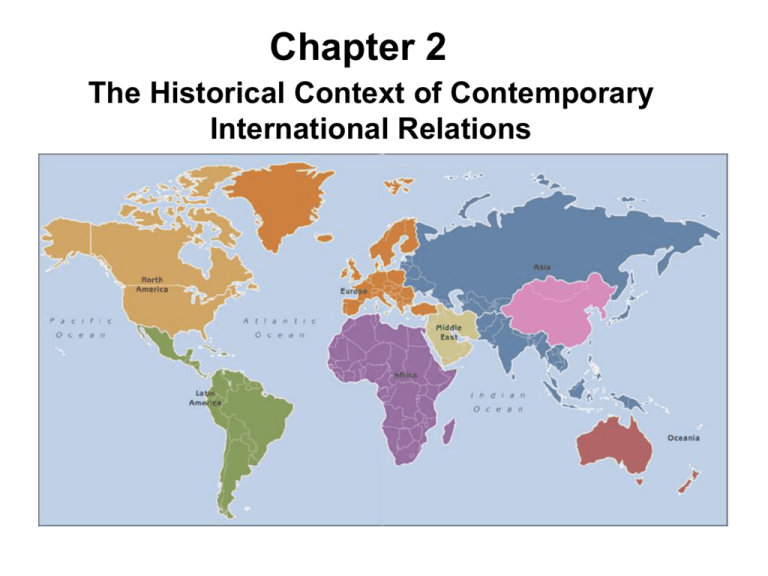
Chapter 2 The Historical Context of Contemporary International Relations Contemporary International System • Key concepts – state, nation, sovereignty, power, international state system, balance of power • Key historical moment – 1648, Treaty of Westphalia, ending Thirty Years War; emergence of modern state system – Secular authority replaced religious authority – Territorial integrity of states as legally equal and sovereign participants in international system • Contemporary international system grounded in Europeancentered Western civilization (as Mingst points out, “for better or worse,” p. 15) – Important not to overlook other civilizations and their impact on international system including India, China, Japan, S.E. Asia, Central and South America (Aztec, Maya, Inca), Africa (Mali, Ghana), among others Key Developments Pre-Westphalia • Greek city-states (circa 400 B.C.) – Classic power politics, diplomacy, economic relations, trade, and military conflict; precursor of modern state system • Roman Empire (50 B.C.-400 A.D.) – Larger, centralized political system through imperial expansion; empire united through law and language • Middle Ages (400-1000) – Disintegration of Roman Empire, emergence of feudalism in Europe and rise of Roman Catholic Church – Emergence of three major civilizations: Arabic, Byzantine, remains of Holy Roman Empire • Late Middle Ages (1000-1600) – Secular trends undermine decentralization of feudalism, universalism of Christianity in Europe – Commercial activity expands, communications and technologies improve – Emergence of transnational business community, revival of classicism, and European territorial expansion (principally due to new technologies and economic interests) Emergence Of Westphalian System • Treaty of Westphalia (1648) ended Thirty Years War (1618-1648) in Europe – Thirty Years War – fought mainly in Germany; initially conflict between Protestants and Catholics (in Holy Roman Empire); grew into larger conflict involving major European powers • European states embraced notion of sovereignty • States established national militaries • Established core group of states that dominated world until beginning of 19th century Sovereignty • Key theorist: French philosopher Jean Bodin (1530-1596): – “absolute and perpetual power vested in a commonwealth” – “distinguishing mark of the sovereign that he cannot in any way be subject to the commands of another, for it is he who makes law for the subject, abrogates law already made, and amends obsolete law” • Although absolute, not without limits; leaders limited by: – Divine law or natural law (laws of God and nature) – Type of regime, constitutional laws of the realm – Covenants, contracts (with people within commonwealth), and treaties with other states (with no supreme arbiter in relations among states) • Sovereignty = authority of the state, based on recognition by other states and nonstate actors, to govern matters within its own borders that affect its people, economy, security, and form of government Key Effects of Westphalia • Sovereignty – Small states in central Europe attain sovereignty (demise of H.R.E.) – Monarchs inherit religious authority over people (sovereign authority, exclusive rights within given territory) – Territoriality, territorial state legitimized – Right of states to choose religion, determine domestic policies free from external pressure with full jurisdiction; right of noninterference • State leaders establish permanent national militaries and centralize control producing ever-more powerful sovereign states with national armies • Core group of states – Austria, Russia, Prussia, England, France, United Provinces (Neth./Belgium) emerge as dominant players – In west, capitalism emerges: private enterprise, infrastructure, trade – In east, feudalism remains, economic change stifled – European politics marked by absolutist regimes, multiple rivalries, and shifting alliances 19th Century Europe: Key Principles • American and French revolutions against absolutist rule, Enlightenment thinking and social contract theorists, usher in 19th century • Absolute rule subject to limits imposed by man – Locke: political power rests with people; monarch/leader/government derives legitimacy (moral and legal right to rule) from consent of governed • Nationalism: people share devotion and allegiance to nation based on shared characteristics, common religion, language, historical experience, etc. Developments in 19th Century Europe • Concert of Europe (Napoleon defeated in 1815, Congress of Vienna), establishes period of relative peace – Great powers meet periodically (Britain, Austria, Russia, and Prussia) to reach agreement on problems threatening peace among European states – Initially aimed at containing France, achieve balance of power; maintain territorial arrangements made at Congress of Vienna (1814-1815); kept relative peace for about 40 years • Major economic, technological, and political changes – Populations and commerce grew – Italy and Germany unified; Holland split (Netherlands, Belgium); Greece, Moldavia, Romania achieved independence • No wars among great powers. Why? Explaining 19th Century Peace • European solidarity • European elites united by fear of revolution from below • Preoccupied by German and Italian unification • European states engaged in territorial expansion, colonialism; “Gold, God, Glory” (hence, competition exported to Africa and Asia) – Congress of Berlin (1885) divided Africa – European states controlled 4/5 of world (1914) • Balance of power – Out of fear for emergence of hegemon, states with relatively equal power formed alliances to counteract any potentially more powerful faction – Breaks down when alliances solidify, two camps emerge – Triple Alliance (Germany, Austria, Italy) and Dual Alliance (France and Russia) – and conflict between allied states leads to World War I Key Developments in Interwar Years • Three empires collapse leading to resurgent nationalisms – Russia by revolution – Austro-Hungarian Empire by dismemberment (Austria, Hungary, Czechoslovakia, parts of Yugoslavia and Romania) – Ottoman Empire by external wars, internal turmoil (Turkey) • Germany dissatisfied with Treaty of Versailles (ending WWI) and reparations – provides climate for rise of Hitler (who finds allies in Italy and Japan) • League of Nations, IGO formed to promote diplomacy, economic liberalism, association and prevention of future wars did not have political weight, legal instruments, or legitimacy to fulfill mandate – Unable to respond to widespread economic unrest or Japanese, Italian and German aggression – Leads to formation of Axis (Germany, Italy, Japan) and Allied Powers (U.S.S.R., England, France, U.S.) Aftermath of WWII: Cold War • Atlantic Charter (U.S., G.B., U.S.S.R.) evolves into United Nations; Axis powers defeated; power redistributed, political borders altered • Key outcomes of WWII – Emergence of two superpowers – U.S. and Soviet Union as primary actors (relative decline of Europe) – Fundamental differences in national interests and ideology (capitalism vs. socialism) leads to 45 years of high level tension, competition, and crises between the superpowers, but not direct military conflict – Development of NATO and Warsaw Pact – Gradual end of colonialism – Cold War competition played out through third-parties, clients, proxies throughout the entire globe IMPORTANT EVENTS OF THE COLD WAR 1 Cold War: Series of Major Crises and “Long Peace” • Berlin blockade (1949), Korean War (1950-53), Cuban missile crisis (1962), Vietnam War, proxy wars in Middle East, Africa, Asia, South/Central America • Why “long peace”? absence of war between great powers? According to Gaddis: – Nuclear deterrence (mutually assured destruction, MAD) – Parity of power (i.e., bipolarity) system stability – U.S. economic hegemony paid for stability – Economic liberalism transnationalized politics creating interests, coalitions across state borders – Long historical cycles of war (every 100-150 years) driven by uneven economic growth Post-Cold War World • Change made in Soviet/Russian foreign policy, withdrawal from Afghanistan, Angola in late 1980’s; glasnost and perestroika • Explanations for change/breakup of Soviet Union: West’s preparations for war, military strength, strong alliance system; Western power and policy; events within USSR; economic, bureaucratic failure…unclear, probably multiple factors • Key developments in post-Cold War world (“New World Order”) – Iraqi invades Kuwait (1990); multilateral response unites former Cold War adversaries – Yugoslavia disintegrates into independent states; civil war in Bosnia and Kosovo; U.N. and NATO respond – Widespread ethnic conflict arises in Central and Western Africa, Central Asia, Indian subcontinent – Al Qaeda attack on 9/11, US war on terror; US and coalition invades Afghanistan – US invades, occupies Iraq • Looking ahead: unipolarity, multipolarity; cooperation or conflict among great powers? Discussion Questions 1. Why was the Treaty of Westphalia important for international relations? What concepts and principles informed it? What changes did it set in motion? How might contemporary IR be different without the Treaty of Westphalia? 2. What are the most important reasons for the relative peace that characterized nineteenth-century Europe? Do you think any principles of nineteenth-century European politics are applicable to contemporary IR? 3. What started the Cold War, and how was it different from previous ones within the international system? What are its lasting effects on U.S.Russian relations and IR more broadly? 4. John Lewis Gaddis and other scholars refer to the Cold War as “the long peace.” Do you agree with this characterization? Include in your response a discussion of Gaddis’s assertions. 5. Did the end of the Cold War mark the beginning of a “New World Order,” or did it have little effect on IR? Draw on your knowledge of history and specific contemporary events to support your position.

